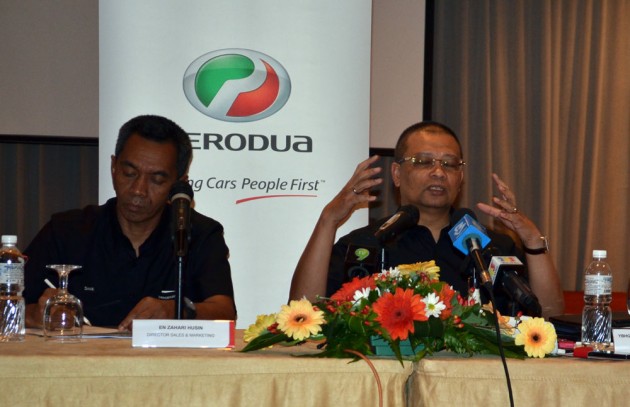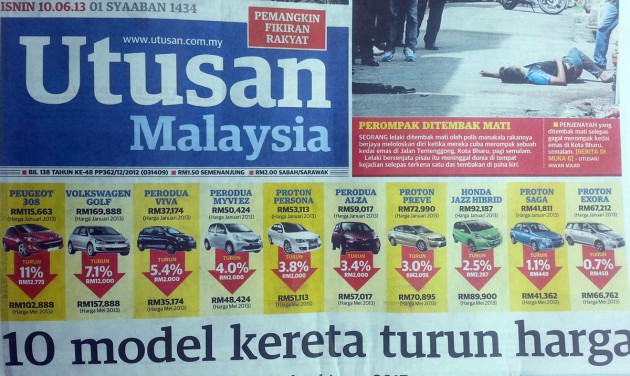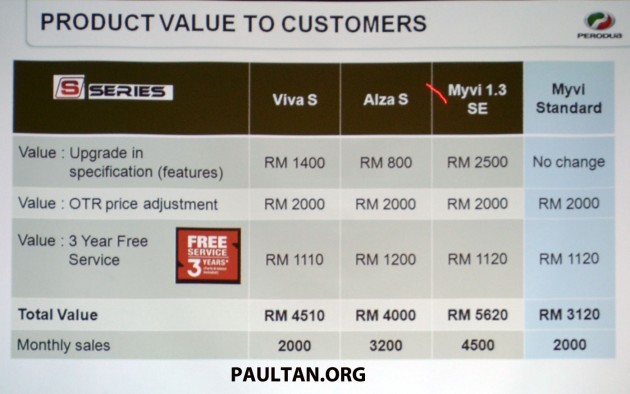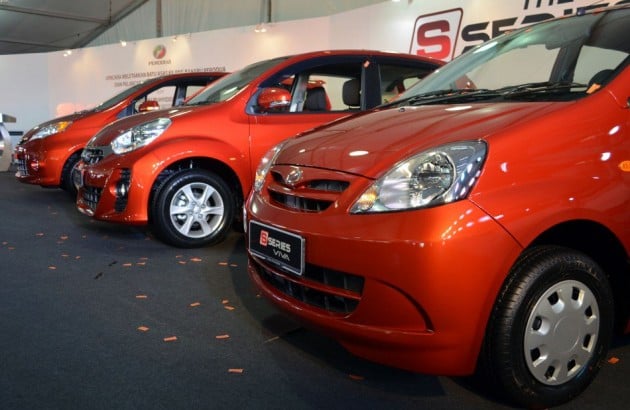The issue of car prices in Malaysia has been simmering until Pakatan Rakyat turned up the heat by making ‘Turunkan Harga Kereta’ as part of its election manifesto. The government then responded to the issue by saying that it will gradually reduce car prices by 20% to 30%.
Earlier this month, Utusan Malaysia front paged a story with the headline “10 Model Kereta Turun Harga”. The report carried an infographic featuring models from the Volkswagen Golf and Peugeot 308 to local favourites like the Proton Saga and Perodua Myvi with before (Jan 2013) and after (May 2013) prices, plus the percentage of price reduction.
However, those who follow the car industry would have questioned some of the numbers at first sight, and it wasn’t long before the certain carmakers came out to refute the figures cited by the report. Perodua went to the extent of calling a press conference to clarify things, which we attended yesterday evening in KL.
“With regards to the article on Utusan Malaysia titled “10 Model Kereta Turun Harga” on page one dated June 10, Perodua wishes to clarify that the reduction mentioned is referred to the reduction to the cost of ownership, as well as improving the value proposition to our customers with the introduction of the S-Series as well as the three-year free service package for all our vehicles,” said Datuk Aminar Rashid Salleh, president and CEO of Perodua.
“With the launch of Perodua’s S-Series, we are able to give our customers greater value for money products and services by way of price rationalisation as well as free service for three years. Perodua has also extended the three years free service package to all its variants this year in conjunction with our 20th anniversary,” he added.
At the S-Series launch, it was explained that the S-Series cars (Viva S, Myvi 1.3 SE and Alza S) were replacements for certain discontinued variants (Viva BZ, Myvi 1.3 Premium and Alza Standard), and compared to the outgoing variants, S-Series cars were cheaper by RM2,000, had added equipment, and came with three years of free service.
“For the S-Series that we launched in March, the monetary value we give to our customers for both in increased specifications as well as the three-year free service package is worth between RM4,000 and RM5,600,” he pointed out, urging reporters to focus on total ownership cost, as opposed to the on-the-road price alone.
To offer the customer effective savings of up to RM5,600 means that costs have to be reduced on Perodua’s end, something that does not happen overnight.
“This is done via cost reduction activities carried out throughout the entire supply chain including improving efficiency and eliminating wastages, which started two and a half years ago. Perodua has been in engagement with the government, through MITI and MAI, since three years ago by providing input to improve further on the yet to be announced revised NAP,” Aminar explained.
The former UMW Toyota top exec shared that Perodua’s cost saving target was 15% by the end of 2012, a figure they missed by just 3%. The long term target is to reduce costs by 30% by 2016, something described as vital for the company’s survival come market liberalisation.
Like Proton’s new Saga SV, the Perodua S-Series is the first fruit of our national carmakers’ drive to reduce costs and increase efficiency, with the net result of cheaper cars. That’s a good thing, any way you slice it.
Looking to sell your car? Sell it with Carro.





















AI-generated Summary ✨
The comments reflect a mix of skepticism and support regarding the perceived reduction in car prices by Perodua, with many accurring that the actual savings are minimal or just marketing strategies, such as adding accessories or raising specifications to justify prices. Several comments criticize the government for not reducing taxes or excise duty, which they believe is the main factor keeping car prices high. There is frustration over persistent high costs, taxation, and quality issues, with some sarcastic remarks about safety and value. Others express hope for further price reductions if taxes are lowered, contrasting Malaysia’s automotive situation unfavorably with countries with better public transportation. Overall, there is doubt about genuine price cuts, and many see it as a strategy to appease consumers without addressing core issues like taxes and industry inefficiencies.